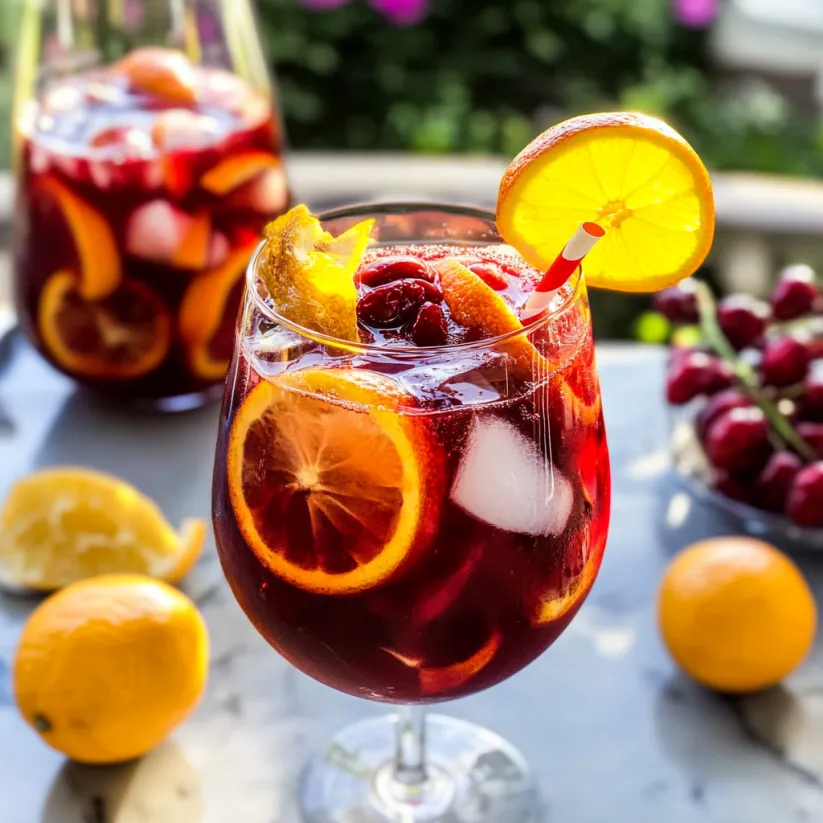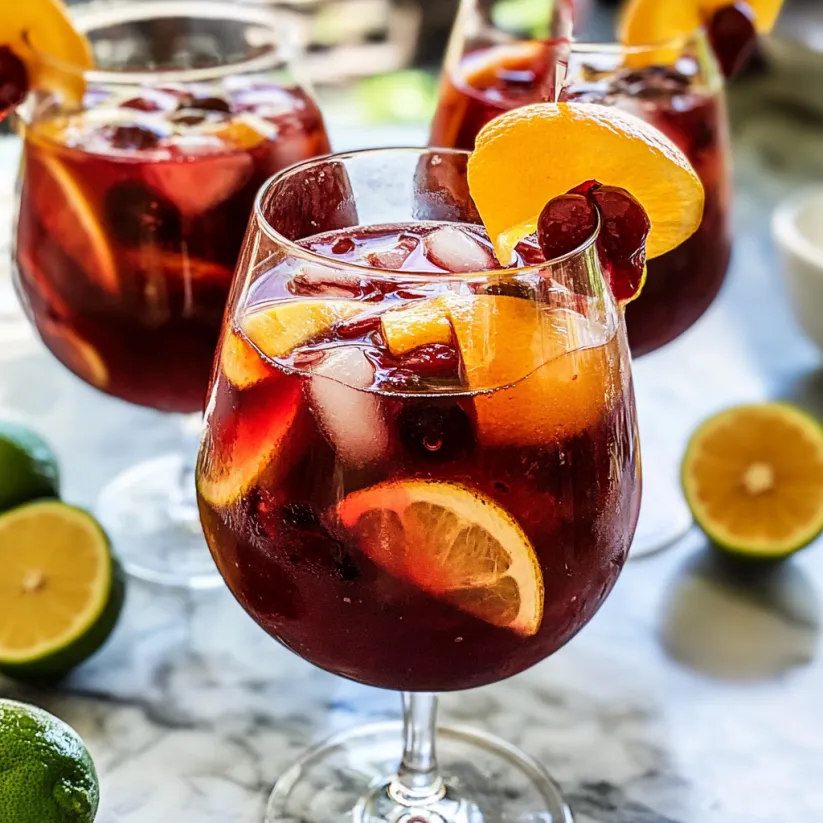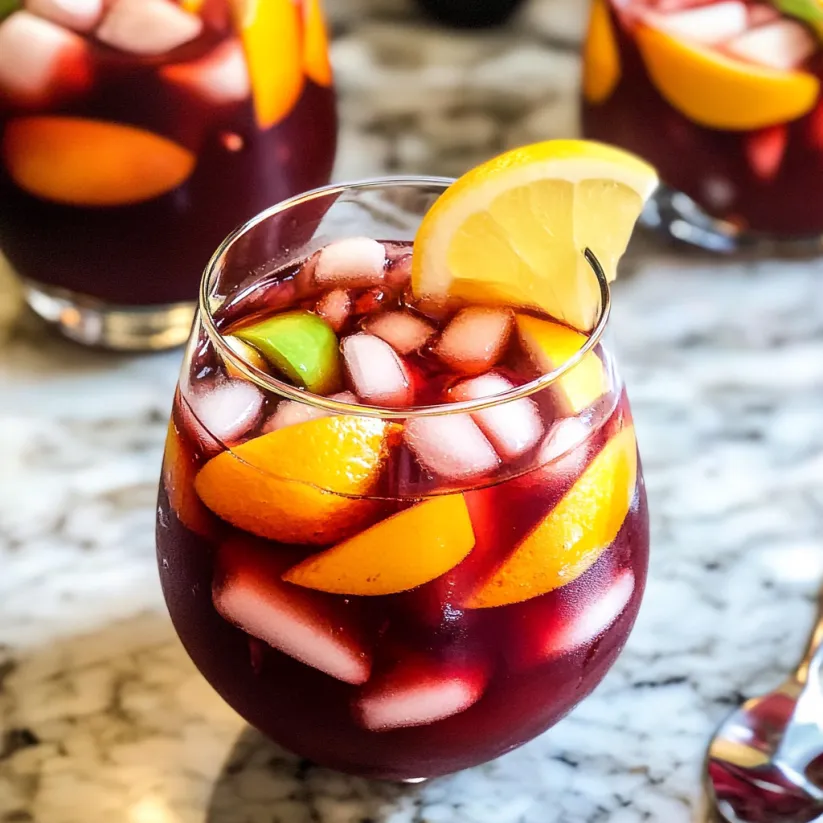 Save Pin
Save Pin
This vibrant red sangria recipe has become my summer entertaining staple, perfect for gatherings where I want something impressive yet effortless. The combination of rich wine and fresh fruits creates a refreshing drink that feels both festive and relaxed.
I first created this sangria recipe during a backyard barbecue when guests unexpectedly stayed late into the evening. The pitcher disappeared so quickly that I now always prepare a double batch when hosting.
Ingredients
- Red wine: one bottle preferably Garnacha or Pinot Noir for their fruity profiles and moderate tannins that blend beautifully with fruit
- Orange juice: adds natural sweetness and bright citrus notes that balance the wine
- Brandy or cognac: provides depth and a warming quality that elevates this from simple wine punch
- Simple syrup: completely optional but helpful if you prefer a sweeter sangria or if your fruit isn't especially ripe
- Lemon: sliced into quarters adds a bright acidity that keeps the sangria from being cloying
- Large orange: quartered brings classic Spanish flavor and gorgeous color to your pitcher
- Fresh berries: such as strawberries cherries raspberries blueberries or blackberries add natural sweetness and vibrant color
Step-by-Step Instructions
- Combine everything:
- Add all ingredients to a large pitcher. Pour in the wine first, followed by orange juice, brandy, and simple syrup if using. This order ensures proper mixing. Add all fruit pieces last, gently stirring to distribute throughout the liquid without crushing the delicate berries.
- Serve properly:
- Either add ice directly to individual serving glasses before pouring the sangria, or chill the sangria pitcher in the refrigerator beforehand. Avoiding ice in the main pitcher prevents dilution if you plan to enjoy it over several hours. Make sure each glass gets a generous helping of the soaked fruit.
 Save Pin
Save Pin
My favorite part of serving sangria is watching guests discover the wine soaked fruit at the bottom of their glasses. My sister in law once declared the brandy infused oranges "the best part of summer" and now requests them specifically whenever she visits.
The Perfect Wine Selection
Choosing the right wine for your sangria makes a tremendous difference in the final flavor. While traditional Spanish sangria often features Tempranillo, I've found Garnacha and Pinot Noir work beautifully for American palates. These wines offer fruit forward profiles that enhance rather than compete with the fresh fruit. Avoid heavily oaked wines like some Cabernets which can overpower the delicate fruit flavors. Whatever you choose, use a wine you would enjoy drinking on its own, as it remains the foundation of your sangria.
Make Ahead Magic
One of the greatest advantages of sangria is how it improves with time. I recommend making this recipe at least 4 hours before serving, though overnight is ideal. The extended resting time allows the fruit to infuse the wine with their essences while simultaneously absorbing the flavors of the alcohol. The result is a more complex, harmonious beverage where no single element dominates. If preparing the day before, wait to add carbonated ingredients like sparkling water until just before serving to maintain effervescence.
Seasonal Variations
Summer offers the classic version with berries, but sangria can be adapted year round. In fall, try apples, pears and cinnamon sticks for a warming version. Winter sangria works beautifully with citrus segments, pomegranate arils and star anise. Spring calls for strawberries, rhubarb and mint. The basic formula remains the same, allowing you to highlight the best produce of each season. This adaptability has made sangria a permanent fixture on my entertaining menu regardless of the month.
Serving Suggestions
Sangria pairs wonderfully with Spanish tapas like garlic shrimp, Manchego cheese, and Serrano ham. The fruity notes complement spicy foods particularly well, making it perfect alongside patatas bravas or chorizo dishes. For a complete Spanish experience, serve alongside a simple paella. The drink's refreshing nature also makes it an ideal companion for summer barbecues, cutting through rich grilled meats and vegetables with its bright acidity.
 Save Pin
Save Pin
Commonly Asked Questions
- → What type of wine works best for red sangria?
Fruity, medium-bodied red wines like Garnacha (Grenache) or Pinot Noir work best for sangria. These varieties complement the fresh fruit without overwhelming the other flavors. While you don't need an expensive bottle, choose one you'd enjoy drinking on its own as it forms the base of your cocktail.
- → Can I make red sangria ahead of time?
Not only can you make sangria ahead of time, it's actually preferred! Preparing sangria several hours before serving or even the night before allows the flavors to meld together beautifully and gives the fruit time to absorb the wine. Just wait to add ice until serving to prevent dilution.
- → How can I adjust the sweetness of sangria?
The simple syrup in this sangria is optional and entirely adjustable. Before adding any sweetener, taste your mixture as the fruits will naturally add some sweetness. You can add the syrup gradually until you reach your desired sweetness level. Using riper fruits will also increase the natural sweetness.
- → What fruits work best in red sangria?
Traditional red sangria typically includes citrus (oranges and lemons) plus seasonal fruits. Berries like strawberries, cherries, raspberries, and blackberries work beautifully. You can also experiment with apples, peaches, or plums depending on the season. The key is using fresh fruit for the best flavor.
- → Can I substitute the brandy in sangria?
Yes, brandy can be substituted with other spirits. Cognac works perfectly as noted in the recipe, but you could also use Grand Marnier, Triple Sec, or even rum depending on your preference. For a lower-alcohol version, you could reduce the amount of spirits or use additional orange juice instead.
- → How should I serve red sangria?
Serve red sangria in wine glasses over ice, making sure to include some of the wine-soaked fruit in each glass. Rather than adding ice directly to your pitcher (which can dilute the sangria), add ice to individual glasses just before serving. Garnish with fresh fruit slices for an extra festive touch.
